Marketing Consumer Behaviour: A Study of Woolworths in Melbourne
VerifiedAdded on 2023/06/14
|13
|3046
|193
Report
AI Summary
This report analyzes consumer behavior within Woolworths, focusing on the impact of culture and social class on consumer buying decisions. It uses Hofstede's cultural dimensions theory and consumer culture theory to understand the behavior of Indian and Chinese consumers in Melbourne. The report highlights the importance of understanding cultural backgrounds and social strata to tailor effective marketing strategies, including product design, promotion, and pricing. Recommendations include leveraging cultural insights for targeted communication and utilizing digital marketing platforms to reach specific consumer groups. The analysis emphasizes the need for Woolworths to align its marketing mix with the diverse needs and preferences dictated by the social and cultural backgrounds of its customer base to enhance product attachment and loyalty.
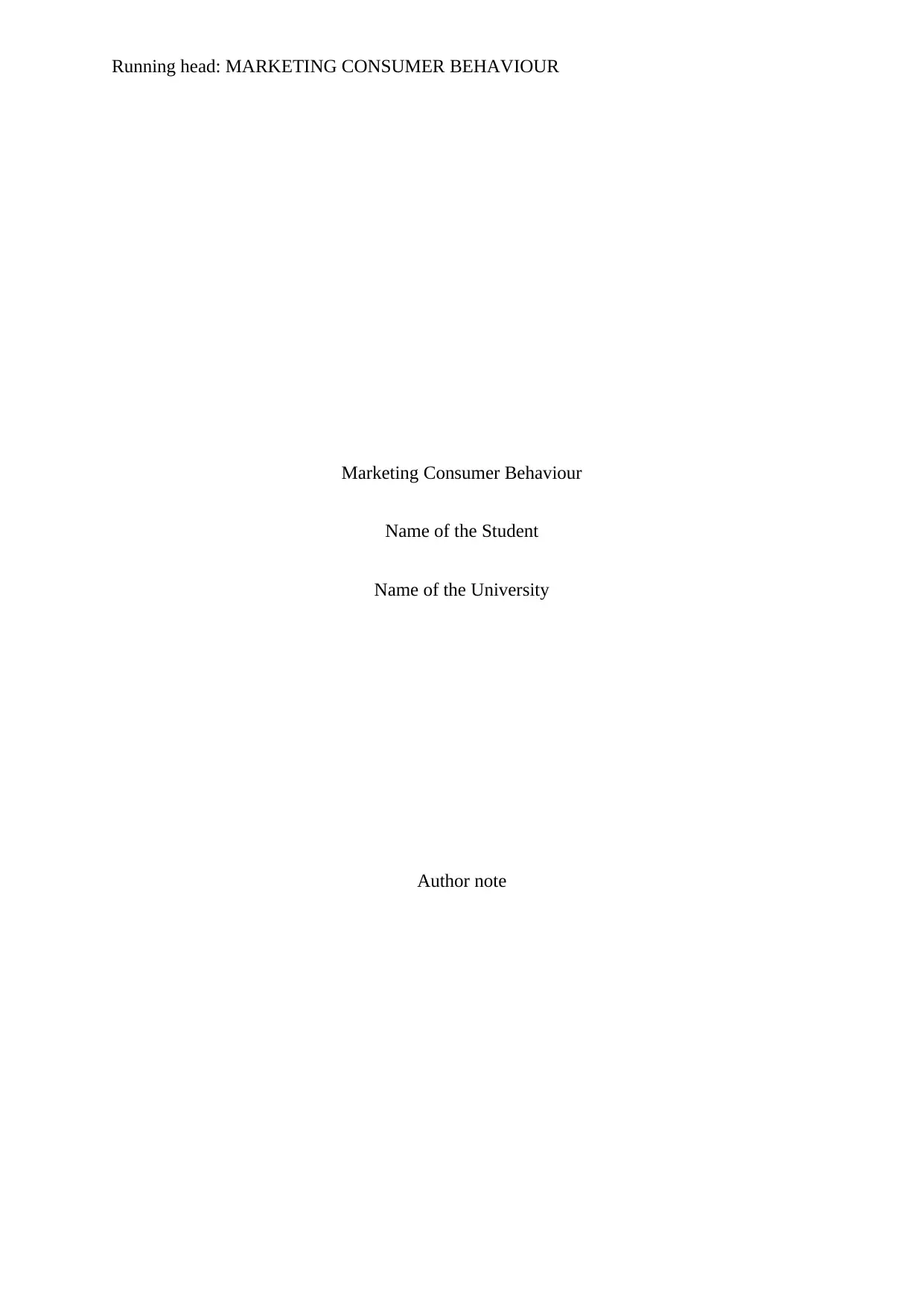
Running head: MARKETING CONSUMER BEHAVIOUR
Marketing Consumer Behaviour
Name of the Student
Name of the University
Author note
Marketing Consumer Behaviour
Name of the Student
Name of the University
Author note
Paraphrase This Document
Need a fresh take? Get an instant paraphrase of this document with our AI Paraphraser
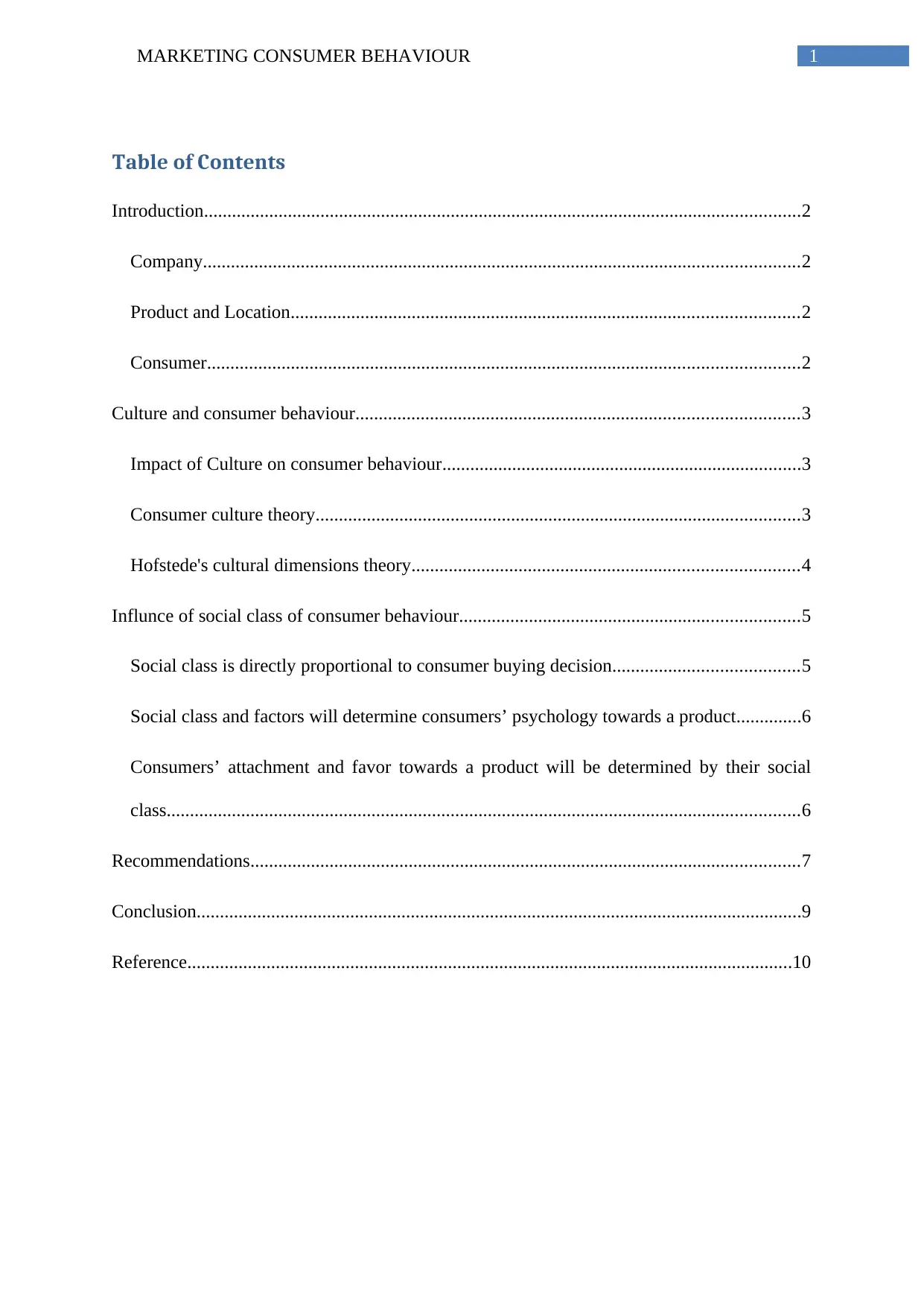
1MARKETING CONSUMER BEHAVIOUR
Table of Contents
Introduction................................................................................................................................2
Company................................................................................................................................2
Product and Location.............................................................................................................2
Consumer...............................................................................................................................2
Culture and consumer behaviour...............................................................................................3
Impact of Culture on consumer behaviour.............................................................................3
Consumer culture theory........................................................................................................3
Hofstede's cultural dimensions theory...................................................................................4
Influnce of social class of consumer behaviour.........................................................................5
Social class is directly proportional to consumer buying decision........................................5
Social class and factors will determine consumers’ psychology towards a product..............6
Consumers’ attachment and favor towards a product will be determined by their social
class........................................................................................................................................6
Recommendations......................................................................................................................7
Conclusion..................................................................................................................................9
Reference..................................................................................................................................10
Table of Contents
Introduction................................................................................................................................2
Company................................................................................................................................2
Product and Location.............................................................................................................2
Consumer...............................................................................................................................2
Culture and consumer behaviour...............................................................................................3
Impact of Culture on consumer behaviour.............................................................................3
Consumer culture theory........................................................................................................3
Hofstede's cultural dimensions theory...................................................................................4
Influnce of social class of consumer behaviour.........................................................................5
Social class is directly proportional to consumer buying decision........................................5
Social class and factors will determine consumers’ psychology towards a product..............6
Consumers’ attachment and favor towards a product will be determined by their social
class........................................................................................................................................6
Recommendations......................................................................................................................7
Conclusion..................................................................................................................................9
Reference..................................................................................................................................10
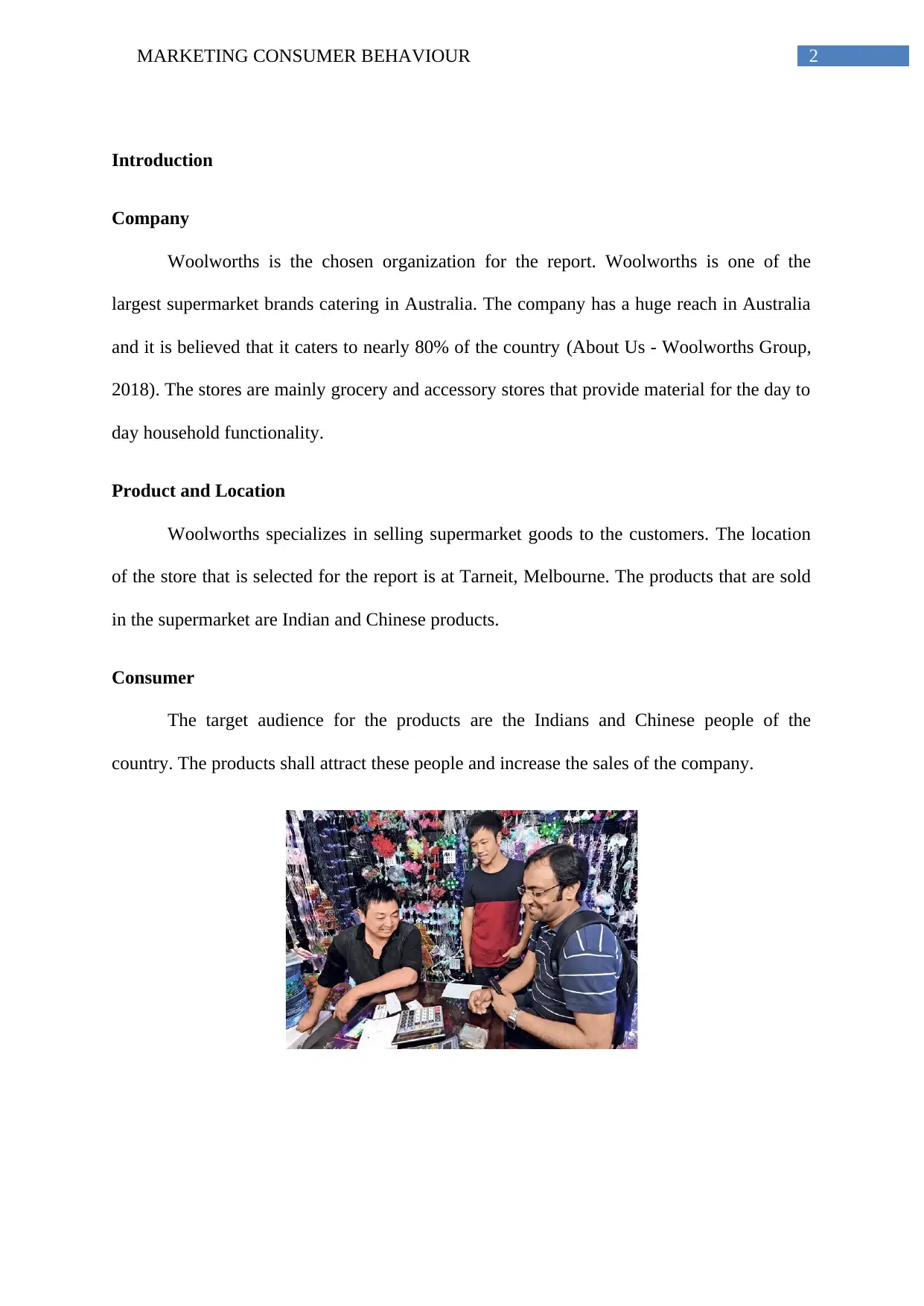
2MARKETING CONSUMER BEHAVIOUR
Introduction
Company
Woolworths is the chosen organization for the report. Woolworths is one of the
largest supermarket brands catering in Australia. The company has a huge reach in Australia
and it is believed that it caters to nearly 80% of the country (About Us - Woolworths Group,
2018). The stores are mainly grocery and accessory stores that provide material for the day to
day household functionality.
Product and Location
Woolworths specializes in selling supermarket goods to the customers. The location
of the store that is selected for the report is at Tarneit, Melbourne. The products that are sold
in the supermarket are Indian and Chinese products.
Consumer
The target audience for the products are the Indians and Chinese people of the
country. The products shall attract these people and increase the sales of the company.
Introduction
Company
Woolworths is the chosen organization for the report. Woolworths is one of the
largest supermarket brands catering in Australia. The company has a huge reach in Australia
and it is believed that it caters to nearly 80% of the country (About Us - Woolworths Group,
2018). The stores are mainly grocery and accessory stores that provide material for the day to
day household functionality.
Product and Location
Woolworths specializes in selling supermarket goods to the customers. The location
of the store that is selected for the report is at Tarneit, Melbourne. The products that are sold
in the supermarket are Indian and Chinese products.
Consumer
The target audience for the products are the Indians and Chinese people of the
country. The products shall attract these people and increase the sales of the company.
⊘ This is a preview!⊘
Do you want full access?
Subscribe today to unlock all pages.

Trusted by 1+ million students worldwide
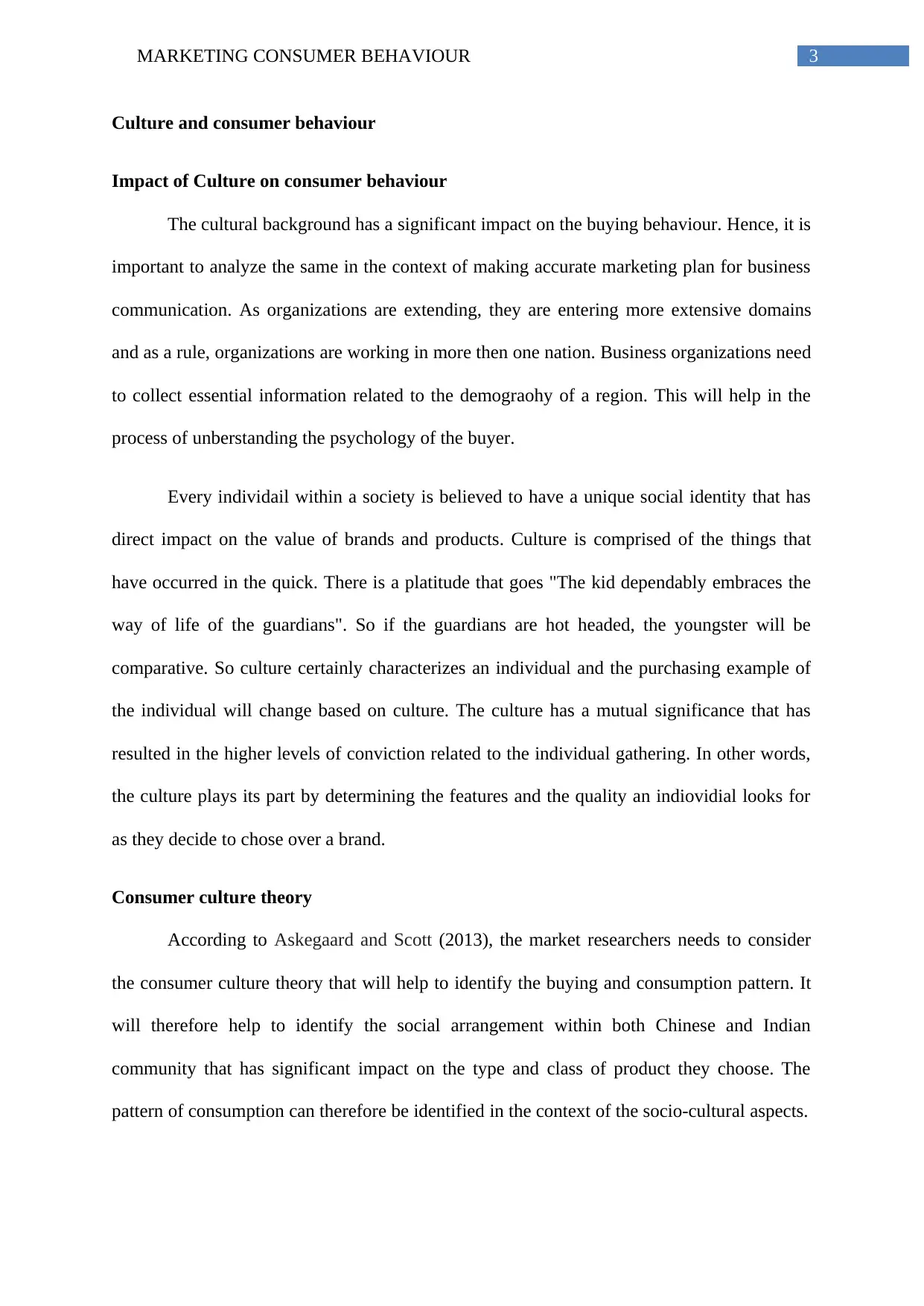
3MARKETING CONSUMER BEHAVIOUR
Culture and consumer behaviour
Impact of Culture on consumer behaviour
The cultural background has a significant impact on the buying behaviour. Hence, it is
important to analyze the same in the context of making accurate marketing plan for business
communication. As organizations are extending, they are entering more extensive domains
and as a rule, organizations are working in more then one nation. Business organizations need
to collect essential information related to the demograohy of a region. This will help in the
process of unberstanding the psychology of the buyer.
Every individail within a society is believed to have a unique social identity that has
direct impact on the value of brands and products. Culture is comprised of the things that
have occurred in the quick. There is a platitude that goes "The kid dependably embraces the
way of life of the guardians". So if the guardians are hot headed, the youngster will be
comparative. So culture certainly characterizes an individual and the purchasing example of
the individual will change based on culture. The culture has a mutual significance that has
resulted in the higher levels of conviction related to the individual gathering. In other words,
the culture plays its part by determining the features and the quality an indiovidial looks for
as they decide to chose over a brand.
Consumer culture theory
According to Askegaard and Scott (2013), the market researchers needs to consider
the consumer culture theory that will help to identify the buying and consumption pattern. It
will therefore help to identify the social arrangement within both Chinese and Indian
community that has significant impact on the type and class of product they choose. The
pattern of consumption can therefore be identified in the context of the socio-cultural aspects.
Culture and consumer behaviour
Impact of Culture on consumer behaviour
The cultural background has a significant impact on the buying behaviour. Hence, it is
important to analyze the same in the context of making accurate marketing plan for business
communication. As organizations are extending, they are entering more extensive domains
and as a rule, organizations are working in more then one nation. Business organizations need
to collect essential information related to the demograohy of a region. This will help in the
process of unberstanding the psychology of the buyer.
Every individail within a society is believed to have a unique social identity that has
direct impact on the value of brands and products. Culture is comprised of the things that
have occurred in the quick. There is a platitude that goes "The kid dependably embraces the
way of life of the guardians". So if the guardians are hot headed, the youngster will be
comparative. So culture certainly characterizes an individual and the purchasing example of
the individual will change based on culture. The culture has a mutual significance that has
resulted in the higher levels of conviction related to the individual gathering. In other words,
the culture plays its part by determining the features and the quality an indiovidial looks for
as they decide to chose over a brand.
Consumer culture theory
According to Askegaard and Scott (2013), the market researchers needs to consider
the consumer culture theory that will help to identify the buying and consumption pattern. It
will therefore help to identify the social arrangement within both Chinese and Indian
community that has significant impact on the type and class of product they choose. The
pattern of consumption can therefore be identified in the context of the socio-cultural aspects.
Paraphrase This Document
Need a fresh take? Get an instant paraphrase of this document with our AI Paraphraser

4MARKETING CONSUMER BEHAVIOUR
Askegaard (2015), has mentioned that in order to apply this theory, it is essential to
conduct marketing research for information gathering from the target customers. It therefore
be possible to predict all type of changes that can occur in a market. It will also allow the
marketers to understand its challenges in the existing business environment. Information that
are gathered are mostly from the cultural background of a society.
Hofstede's cultural dimensions theory
Petersen, Kushwaha and Kumar (2015), have mentioned about the importance of the
Hofstede's cultural dimensions theory, which uses a particular framework to identify the
values of culture witin the society that have impact on the individual behaviour. The
elememts of this theory can also be used to compare the difference in the consumer behaviour
of Indian and Chinses community. The element of individualism highlights about the degree
of Independence day society maintains with their fellow members. The Indian society has an
intermediate score on the individualism elements. Hence, the choice of products and brand
within the Indian consumer is highly dependent on the brand preferred by the community.
Hence, the marketing plan for Woolsworth need to imoplemet the staratgy of market
segmentation. Here, it will be possible to identify a common group of consumers, who have
low to inetermediate levels of individualism. As a certain groups of the Indian community
will chose a particular brand, the organization can easily influence other people for
influencing their buying behavior.
The Chinese community as much lower score in the element of individualism. Hence
it will be easily possible to influence the buying behaviour of the Chinese people, and
implement the policy of target marketing. The company therefore need to target the Particular
group of consumers who can easily be influenced by effective marketing communication.
Uncertainty avoidance factor is another important element within the Hofstede's
cultural dimensions theory that can help to deal with the issues of predicting the changes in
Askegaard (2015), has mentioned that in order to apply this theory, it is essential to
conduct marketing research for information gathering from the target customers. It therefore
be possible to predict all type of changes that can occur in a market. It will also allow the
marketers to understand its challenges in the existing business environment. Information that
are gathered are mostly from the cultural background of a society.
Hofstede's cultural dimensions theory
Petersen, Kushwaha and Kumar (2015), have mentioned about the importance of the
Hofstede's cultural dimensions theory, which uses a particular framework to identify the
values of culture witin the society that have impact on the individual behaviour. The
elememts of this theory can also be used to compare the difference in the consumer behaviour
of Indian and Chinses community. The element of individualism highlights about the degree
of Independence day society maintains with their fellow members. The Indian society has an
intermediate score on the individualism elements. Hence, the choice of products and brand
within the Indian consumer is highly dependent on the brand preferred by the community.
Hence, the marketing plan for Woolsworth need to imoplemet the staratgy of market
segmentation. Here, it will be possible to identify a common group of consumers, who have
low to inetermediate levels of individualism. As a certain groups of the Indian community
will chose a particular brand, the organization can easily influence other people for
influencing their buying behavior.
The Chinese community as much lower score in the element of individualism. Hence
it will be easily possible to influence the buying behaviour of the Chinese people, and
implement the policy of target marketing. The company therefore need to target the Particular
group of consumers who can easily be influenced by effective marketing communication.
Uncertainty avoidance factor is another important element within the Hofstede's
cultural dimensions theory that can help to deal with the issues of predicting the changes in
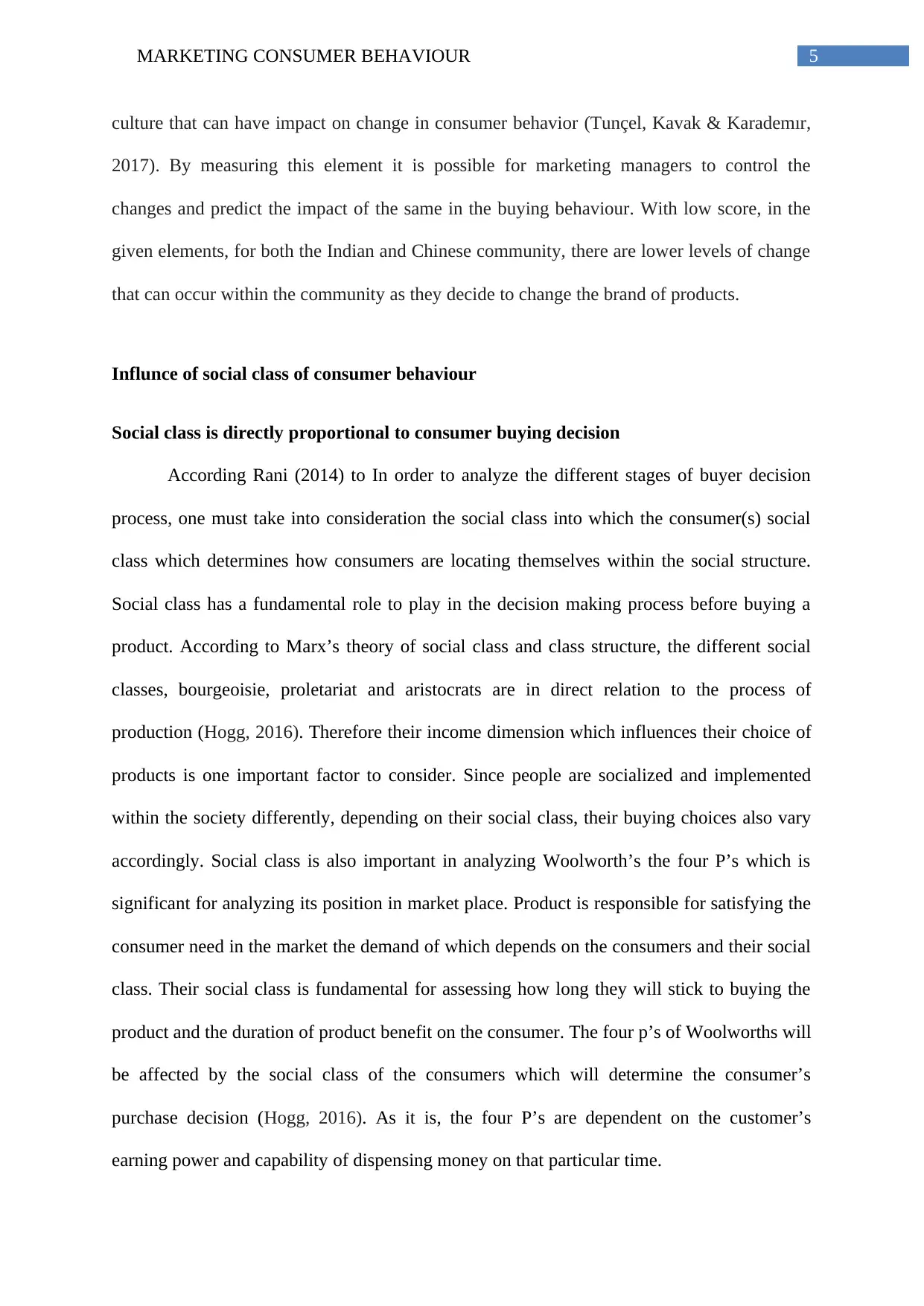
5MARKETING CONSUMER BEHAVIOUR
culture that can have impact on change in consumer behavior (Tunçel, Kavak & Karademır,
2017). By measuring this element it is possible for marketing managers to control the
changes and predict the impact of the same in the buying behaviour. With low score, in the
given elements, for both the Indian and Chinese community, there are lower levels of change
that can occur within the community as they decide to change the brand of products.
Influnce of social class of consumer behaviour
Social class is directly proportional to consumer buying decision
According Rani (2014) to In order to analyze the different stages of buyer decision
process, one must take into consideration the social class into which the consumer(s) social
class which determines how consumers are locating themselves within the social structure.
Social class has a fundamental role to play in the decision making process before buying a
product. According to Marx’s theory of social class and class structure, the different social
classes, bourgeoisie, proletariat and aristocrats are in direct relation to the process of
production (Hogg, 2016). Therefore their income dimension which influences their choice of
products is one important factor to consider. Since people are socialized and implemented
within the society differently, depending on their social class, their buying choices also vary
accordingly. Social class is also important in analyzing Woolworth’s the four P’s which is
significant for analyzing its position in market place. Product is responsible for satisfying the
consumer need in the market the demand of which depends on the consumers and their social
class. Their social class is fundamental for assessing how long they will stick to buying the
product and the duration of product benefit on the consumer. The four p’s of Woolworths will
be affected by the social class of the consumers which will determine the consumer’s
purchase decision (Hogg, 2016). As it is, the four P’s are dependent on the customer’s
earning power and capability of dispensing money on that particular time.
culture that can have impact on change in consumer behavior (Tunçel, Kavak & Karademır,
2017). By measuring this element it is possible for marketing managers to control the
changes and predict the impact of the same in the buying behaviour. With low score, in the
given elements, for both the Indian and Chinese community, there are lower levels of change
that can occur within the community as they decide to change the brand of products.
Influnce of social class of consumer behaviour
Social class is directly proportional to consumer buying decision
According Rani (2014) to In order to analyze the different stages of buyer decision
process, one must take into consideration the social class into which the consumer(s) social
class which determines how consumers are locating themselves within the social structure.
Social class has a fundamental role to play in the decision making process before buying a
product. According to Marx’s theory of social class and class structure, the different social
classes, bourgeoisie, proletariat and aristocrats are in direct relation to the process of
production (Hogg, 2016). Therefore their income dimension which influences their choice of
products is one important factor to consider. Since people are socialized and implemented
within the society differently, depending on their social class, their buying choices also vary
accordingly. Social class is also important in analyzing Woolworth’s the four P’s which is
significant for analyzing its position in market place. Product is responsible for satisfying the
consumer need in the market the demand of which depends on the consumers and their social
class. Their social class is fundamental for assessing how long they will stick to buying the
product and the duration of product benefit on the consumer. The four p’s of Woolworths will
be affected by the social class of the consumers which will determine the consumer’s
purchase decision (Hogg, 2016). As it is, the four P’s are dependent on the customer’s
earning power and capability of dispensing money on that particular time.
⊘ This is a preview!⊘
Do you want full access?
Subscribe today to unlock all pages.

Trusted by 1+ million students worldwide
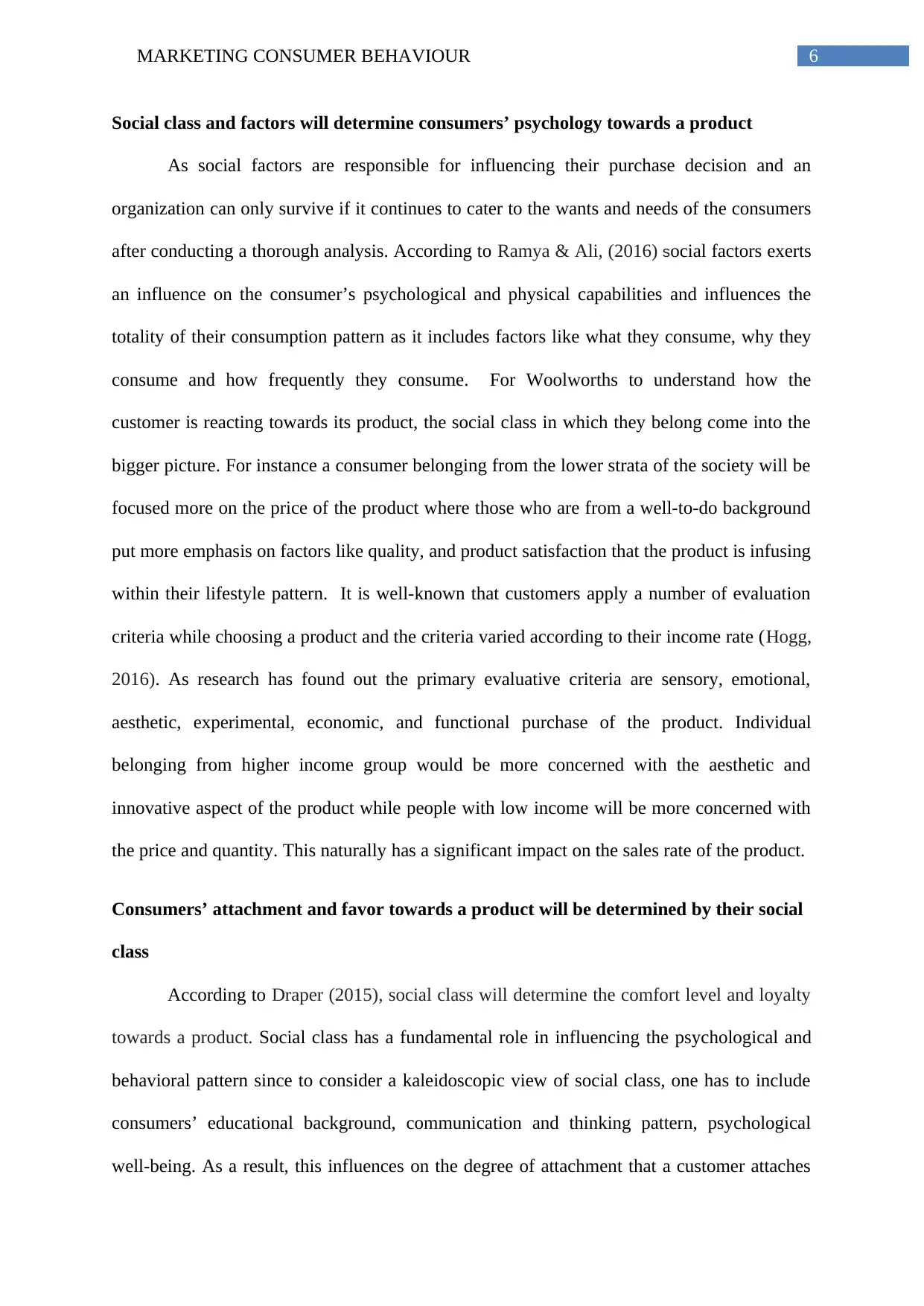
6MARKETING CONSUMER BEHAVIOUR
Social class and factors will determine consumers’ psychology towards a product
As social factors are responsible for influencing their purchase decision and an
organization can only survive if it continues to cater to the wants and needs of the consumers
after conducting a thorough analysis. According to Ramya & Ali, (2016) social factors exerts
an influence on the consumer’s psychological and physical capabilities and influences the
totality of their consumption pattern as it includes factors like what they consume, why they
consume and how frequently they consume. For Woolworths to understand how the
customer is reacting towards its product, the social class in which they belong come into the
bigger picture. For instance a consumer belonging from the lower strata of the society will be
focused more on the price of the product where those who are from a well-to-do background
put more emphasis on factors like quality, and product satisfaction that the product is infusing
within their lifestyle pattern. It is well-known that customers apply a number of evaluation
criteria while choosing a product and the criteria varied according to their income rate (Hogg,
2016). As research has found out the primary evaluative criteria are sensory, emotional,
aesthetic, experimental, economic, and functional purchase of the product. Individual
belonging from higher income group would be more concerned with the aesthetic and
innovative aspect of the product while people with low income will be more concerned with
the price and quantity. This naturally has a significant impact on the sales rate of the product.
Consumers’ attachment and favor towards a product will be determined by their social
class
According to Draper (2015), social class will determine the comfort level and loyalty
towards a product. Social class has a fundamental role in influencing the psychological and
behavioral pattern since to consider a kaleidoscopic view of social class, one has to include
consumers’ educational background, communication and thinking pattern, psychological
well-being. As a result, this influences on the degree of attachment that a customer attaches
Social class and factors will determine consumers’ psychology towards a product
As social factors are responsible for influencing their purchase decision and an
organization can only survive if it continues to cater to the wants and needs of the consumers
after conducting a thorough analysis. According to Ramya & Ali, (2016) social factors exerts
an influence on the consumer’s psychological and physical capabilities and influences the
totality of their consumption pattern as it includes factors like what they consume, why they
consume and how frequently they consume. For Woolworths to understand how the
customer is reacting towards its product, the social class in which they belong come into the
bigger picture. For instance a consumer belonging from the lower strata of the society will be
focused more on the price of the product where those who are from a well-to-do background
put more emphasis on factors like quality, and product satisfaction that the product is infusing
within their lifestyle pattern. It is well-known that customers apply a number of evaluation
criteria while choosing a product and the criteria varied according to their income rate (Hogg,
2016). As research has found out the primary evaluative criteria are sensory, emotional,
aesthetic, experimental, economic, and functional purchase of the product. Individual
belonging from higher income group would be more concerned with the aesthetic and
innovative aspect of the product while people with low income will be more concerned with
the price and quantity. This naturally has a significant impact on the sales rate of the product.
Consumers’ attachment and favor towards a product will be determined by their social
class
According to Draper (2015), social class will determine the comfort level and loyalty
towards a product. Social class has a fundamental role in influencing the psychological and
behavioral pattern since to consider a kaleidoscopic view of social class, one has to include
consumers’ educational background, communication and thinking pattern, psychological
well-being. As a result, this influences on the degree of attachment that a customer attaches
Paraphrase This Document
Need a fresh take? Get an instant paraphrase of this document with our AI Paraphraser

7MARKETING CONSUMER BEHAVIOUR
with a product. Therefore Woolworths will witness varying degrees of brand loyalty from
their customer belonging from different social classes. If a consumer is comfortable with the
product, he/she will show greater loyalty towards it than the one who will explore more
products with better buying options (Murphy & Dweck, 2016). Similarly, a section of
consumer will research more on the type of product they are not satisfied with and stick to
cheaper options with providing greater quantity of product. Therefore the psychological
process of decision making is an important part of social class and sale of a particular
product. Product performance is therefore sensitive to the social class into which consumers
are falling into.
Recommendations
For making most use of the theories and pattern of the consumer behavior within the
Indian and Chinese community, it is recoemended to make use of the 4Ps of marketing.
According to Claiborne and Sirgy (2015), the product design and promotion strategies that
have been implicated will highly depend upon the consumer behaviour. It is recommended
for the promotional team within the organisation, to understand the perspective of cultural
influence on the consumer. This will help them to effectively communicate with the target
group. For example, in case of the Indian Consumer, The promotional agents need to
communicate about the product by providing them information related to the past sales
record. With high level of popularity in particular product it will be easily possible to
influence the buying behaviour of Indian and Chinese customers.
It is also recommended for the promotional team to select appropriate communication
tool to reach out to the target customer group (Öztamur & Karakadılar, 2014). For example in
with a product. Therefore Woolworths will witness varying degrees of brand loyalty from
their customer belonging from different social classes. If a consumer is comfortable with the
product, he/she will show greater loyalty towards it than the one who will explore more
products with better buying options (Murphy & Dweck, 2016). Similarly, a section of
consumer will research more on the type of product they are not satisfied with and stick to
cheaper options with providing greater quantity of product. Therefore the psychological
process of decision making is an important part of social class and sale of a particular
product. Product performance is therefore sensitive to the social class into which consumers
are falling into.
Recommendations
For making most use of the theories and pattern of the consumer behavior within the
Indian and Chinese community, it is recoemended to make use of the 4Ps of marketing.
According to Claiborne and Sirgy (2015), the product design and promotion strategies that
have been implicated will highly depend upon the consumer behaviour. It is recommended
for the promotional team within the organisation, to understand the perspective of cultural
influence on the consumer. This will help them to effectively communicate with the target
group. For example, in case of the Indian Consumer, The promotional agents need to
communicate about the product by providing them information related to the past sales
record. With high level of popularity in particular product it will be easily possible to
influence the buying behaviour of Indian and Chinese customers.
It is also recommended for the promotional team to select appropriate communication
tool to reach out to the target customer group (Öztamur & Karakadılar, 2014). For example in
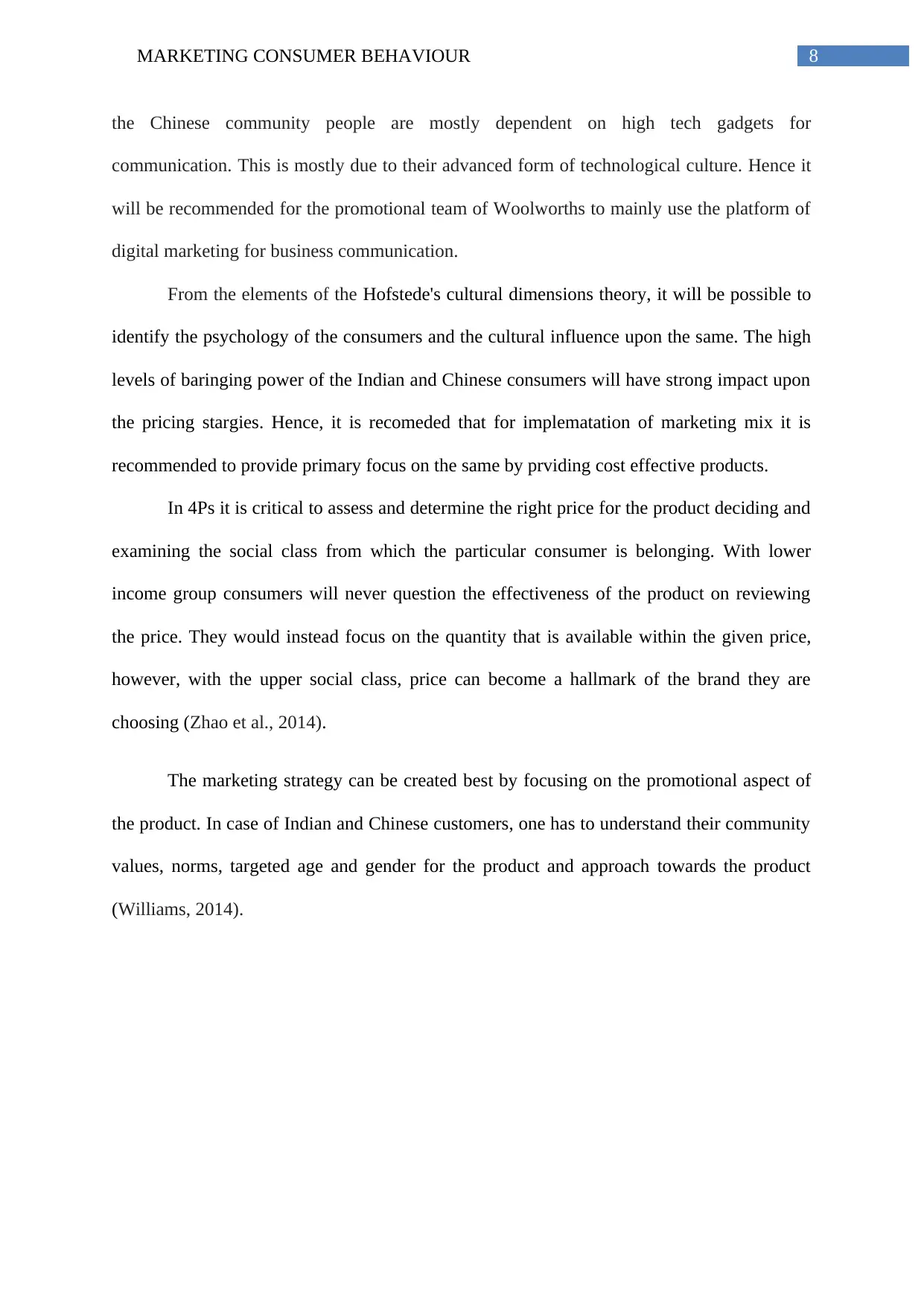
8MARKETING CONSUMER BEHAVIOUR
the Chinese community people are mostly dependent on high tech gadgets for
communication. This is mostly due to their advanced form of technological culture. Hence it
will be recommended for the promotional team of Woolworths to mainly use the platform of
digital marketing for business communication.
From the elements of the Hofstede's cultural dimensions theory, it will be possible to
identify the psychology of the consumers and the cultural influence upon the same. The high
levels of baringing power of the Indian and Chinese consumers will have strong impact upon
the pricing stargies. Hence, it is recomeded that for implematation of marketing mix it is
recommended to provide primary focus on the same by prviding cost effective products.
In 4Ps it is critical to assess and determine the right price for the product deciding and
examining the social class from which the particular consumer is belonging. With lower
income group consumers will never question the effectiveness of the product on reviewing
the price. They would instead focus on the quantity that is available within the given price,
however, with the upper social class, price can become a hallmark of the brand they are
choosing (Zhao et al., 2014).
The marketing strategy can be created best by focusing on the promotional aspect of
the product. In case of Indian and Chinese customers, one has to understand their community
values, norms, targeted age and gender for the product and approach towards the product
(Williams, 2014).
the Chinese community people are mostly dependent on high tech gadgets for
communication. This is mostly due to their advanced form of technological culture. Hence it
will be recommended for the promotional team of Woolworths to mainly use the platform of
digital marketing for business communication.
From the elements of the Hofstede's cultural dimensions theory, it will be possible to
identify the psychology of the consumers and the cultural influence upon the same. The high
levels of baringing power of the Indian and Chinese consumers will have strong impact upon
the pricing stargies. Hence, it is recomeded that for implematation of marketing mix it is
recommended to provide primary focus on the same by prviding cost effective products.
In 4Ps it is critical to assess and determine the right price for the product deciding and
examining the social class from which the particular consumer is belonging. With lower
income group consumers will never question the effectiveness of the product on reviewing
the price. They would instead focus on the quantity that is available within the given price,
however, with the upper social class, price can become a hallmark of the brand they are
choosing (Zhao et al., 2014).
The marketing strategy can be created best by focusing on the promotional aspect of
the product. In case of Indian and Chinese customers, one has to understand their community
values, norms, targeted age and gender for the product and approach towards the product
(Williams, 2014).
⊘ This is a preview!⊘
Do you want full access?
Subscribe today to unlock all pages.

Trusted by 1+ million students worldwide
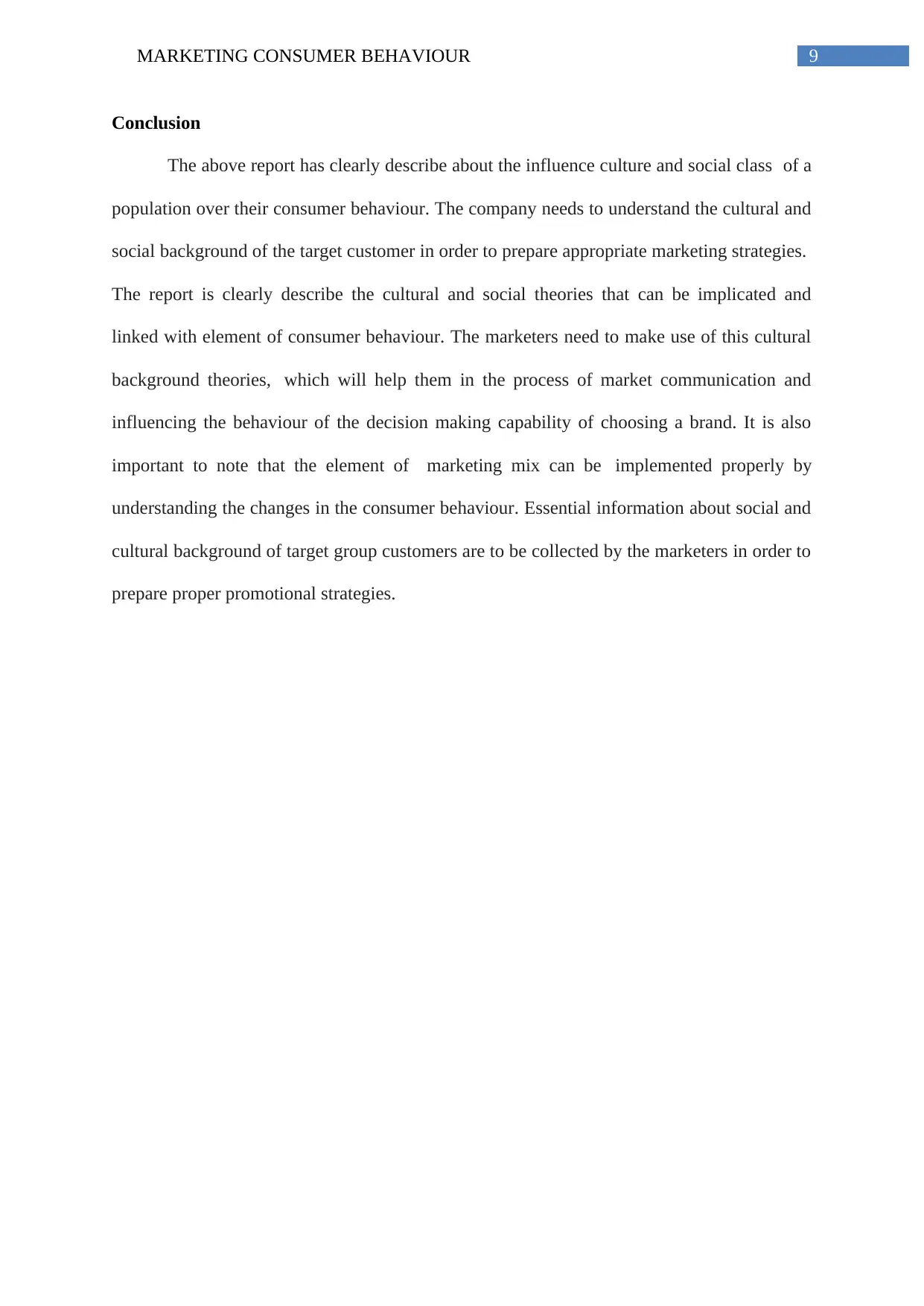
9MARKETING CONSUMER BEHAVIOUR
Conclusion
The above report has clearly describe about the influence culture and social class of a
population over their consumer behaviour. The company needs to understand the cultural and
social background of the target customer in order to prepare appropriate marketing strategies.
The report is clearly describe the cultural and social theories that can be implicated and
linked with element of consumer behaviour. The marketers need to make use of this cultural
background theories, which will help them in the process of market communication and
influencing the behaviour of the decision making capability of choosing a brand. It is also
important to note that the element of marketing mix can be implemented properly by
understanding the changes in the consumer behaviour. Essential information about social and
cultural background of target group customers are to be collected by the marketers in order to
prepare proper promotional strategies.
Conclusion
The above report has clearly describe about the influence culture and social class of a
population over their consumer behaviour. The company needs to understand the cultural and
social background of the target customer in order to prepare appropriate marketing strategies.
The report is clearly describe the cultural and social theories that can be implicated and
linked with element of consumer behaviour. The marketers need to make use of this cultural
background theories, which will help them in the process of market communication and
influencing the behaviour of the decision making capability of choosing a brand. It is also
important to note that the element of marketing mix can be implemented properly by
understanding the changes in the consumer behaviour. Essential information about social and
cultural background of target group customers are to be collected by the marketers in order to
prepare proper promotional strategies.
Paraphrase This Document
Need a fresh take? Get an instant paraphrase of this document with our AI Paraphraser

10MARKETING CONSUMER BEHAVIOUR
Reference
About Us - Woolworths Group. (2018). Woolworthsgroup.com.au. Retrieved 7 April 2018,
from https://www.woolworthsgroup.com.au/page/about-us
Askegaard, S. (2015). Consumer Culture Theory (CCT). The Wiley Blackwell Encyclopedia
of Consumption and Consumer Studies DOI:
https://doi.org/10.1002/9781118989463.wbeccs054
Askegaard, S., & Scott, L. (2013). Consumer culture theory: The ironies of history. DOI:
10.1177/1470593113479007
Claiborne, C. B., & Sirgy, M. J. (2015). Self-image congruence as a model of consumer
attitude formation and behavior: A conceptual review and guide for future research. In
Proceedings of the 1990 academy of marketing science (AMS) annual conference (pp.
1-7). Springer, Cham., DOI: https://doi.org/10.1007/978-3-319-13254-9_1
Draper, D. (2015). Am I in the right class? Social class and its effect on the educational
experience. Diffusion-The UCLan Journal of Undergraduate Research, 3(2). Retrived
from http://bcur.org/journals/index.php/Diffusion/article/view/157
Hogg, M. A. (2016). Social identity theory. In Understanding peace and conflict through
social identity theory (pp. 3-17). Springer, Cham. Retrived from:
https://link.springer.com/chapter/10.1007/978-3-319-29869-6_1
Murphy, M. C., & Dweck, C. S. (2016). Mindsets shape consumer behavior. Journal of
Consumer Psychology, 26(1), 127-136. https://doi.org/10.1016/j.jcps.2015.06.005
Öztamur, D., & Karakadılar, İ. S. (2014). Exploring the role of social media for SMEs: as a
new marketing strategy tool for the firm performance perspective. Procedia-Social
and behavioral sciences, 150, 511-520, DOI: 10.1016/j.sbspro.2014.09.067
Reference
About Us - Woolworths Group. (2018). Woolworthsgroup.com.au. Retrieved 7 April 2018,
from https://www.woolworthsgroup.com.au/page/about-us
Askegaard, S. (2015). Consumer Culture Theory (CCT). The Wiley Blackwell Encyclopedia
of Consumption and Consumer Studies DOI:
https://doi.org/10.1002/9781118989463.wbeccs054
Askegaard, S., & Scott, L. (2013). Consumer culture theory: The ironies of history. DOI:
10.1177/1470593113479007
Claiborne, C. B., & Sirgy, M. J. (2015). Self-image congruence as a model of consumer
attitude formation and behavior: A conceptual review and guide for future research. In
Proceedings of the 1990 academy of marketing science (AMS) annual conference (pp.
1-7). Springer, Cham., DOI: https://doi.org/10.1007/978-3-319-13254-9_1
Draper, D. (2015). Am I in the right class? Social class and its effect on the educational
experience. Diffusion-The UCLan Journal of Undergraduate Research, 3(2). Retrived
from http://bcur.org/journals/index.php/Diffusion/article/view/157
Hogg, M. A. (2016). Social identity theory. In Understanding peace and conflict through
social identity theory (pp. 3-17). Springer, Cham. Retrived from:
https://link.springer.com/chapter/10.1007/978-3-319-29869-6_1
Murphy, M. C., & Dweck, C. S. (2016). Mindsets shape consumer behavior. Journal of
Consumer Psychology, 26(1), 127-136. https://doi.org/10.1016/j.jcps.2015.06.005
Öztamur, D., & Karakadılar, İ. S. (2014). Exploring the role of social media for SMEs: as a
new marketing strategy tool for the firm performance perspective. Procedia-Social
and behavioral sciences, 150, 511-520, DOI: 10.1016/j.sbspro.2014.09.067

11MARKETING CONSUMER BEHAVIOUR
Petersen, J. A., Kushwaha, T., & Kumar, V. (2015). Marketing communication strategies and
consumer financial decision making: The role of national culture. Journal of
Marketing, 79(1), 44-63. Reterived from:
http://www.diva-portal.org/smash/get/diva2:1003938/FULLTEXT01.pdf#page=59
Ramya, N., & Ali, S. M. (2016). Factors affecting consumer buying behavior. International
Journal of Applied Research, 2(10), 76-80. Retrived from
http://www.allresearchjournal.com/archives/?
year=2016&vol=2&issue=10&part=B&ArticleId=2683
Rani, P. (2014). Factors influencing consumer behaviour. International journal of current
research and academic review, 2(9), 52-61. Retrived from http://www.ijcrar.com/vol-
2-9/Pinki%20Rani.pdf
Tunçel, N., Kavak, B., & Karademır, A. Ç. (2017). Are “Consumer Social Responsibility”
and “Consumer Ethics” Concepts Interchangeable? The Effect of Hofstede’s Cultural
Dimensions 1. Tüketici ve Tüketim Araştırmaları Dergisi= Journal of Consumer and
Consumption Research, 9(1), 35-56. Reterived from:
https://www.researchgate.net/profile/Niray_Tuncel/publication/319205537_Are_Cons
umer_Social_Responsibility_and_Consumer_Ethics_Concepts_Interchangeable_The_
Effect_of_Hofstede%27s_Cultural_Dimensions/links/599b0388aca272dff128d65c/
Are-Consumer-Social-Responsibility-and-Consumer-Ethics-Concepts-
Interchangeable-The-Effect-of-Hofstedes-Cultural-Dimensions.pdf
Williams, P. (2014). Emotions and consumer behavior. Journal of Consumer
Research, 40(5), viii-xi. Retrived from http://www.jstor.org/stable/10.1086/67442
Petersen, J. A., Kushwaha, T., & Kumar, V. (2015). Marketing communication strategies and
consumer financial decision making: The role of national culture. Journal of
Marketing, 79(1), 44-63. Reterived from:
http://www.diva-portal.org/smash/get/diva2:1003938/FULLTEXT01.pdf#page=59
Ramya, N., & Ali, S. M. (2016). Factors affecting consumer buying behavior. International
Journal of Applied Research, 2(10), 76-80. Retrived from
http://www.allresearchjournal.com/archives/?
year=2016&vol=2&issue=10&part=B&ArticleId=2683
Rani, P. (2014). Factors influencing consumer behaviour. International journal of current
research and academic review, 2(9), 52-61. Retrived from http://www.ijcrar.com/vol-
2-9/Pinki%20Rani.pdf
Tunçel, N., Kavak, B., & Karademır, A. Ç. (2017). Are “Consumer Social Responsibility”
and “Consumer Ethics” Concepts Interchangeable? The Effect of Hofstede’s Cultural
Dimensions 1. Tüketici ve Tüketim Araştırmaları Dergisi= Journal of Consumer and
Consumption Research, 9(1), 35-56. Reterived from:
https://www.researchgate.net/profile/Niray_Tuncel/publication/319205537_Are_Cons
umer_Social_Responsibility_and_Consumer_Ethics_Concepts_Interchangeable_The_
Effect_of_Hofstede%27s_Cultural_Dimensions/links/599b0388aca272dff128d65c/
Are-Consumer-Social-Responsibility-and-Consumer-Ethics-Concepts-
Interchangeable-The-Effect-of-Hofstedes-Cultural-Dimensions.pdf
Williams, P. (2014). Emotions and consumer behavior. Journal of Consumer
Research, 40(5), viii-xi. Retrived from http://www.jstor.org/stable/10.1086/67442
⊘ This is a preview!⊘
Do you want full access?
Subscribe today to unlock all pages.

Trusted by 1+ million students worldwide
1 out of 13
Related Documents
Your All-in-One AI-Powered Toolkit for Academic Success.
+13062052269
info@desklib.com
Available 24*7 on WhatsApp / Email
![[object Object]](/_next/static/media/star-bottom.7253800d.svg)
Unlock your academic potential
Copyright © 2020–2025 A2Z Services. All Rights Reserved. Developed and managed by ZUCOL.



